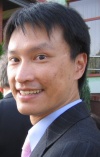Erik Chang: Difference between revisions
Jump to navigation
Jump to search
No edit summary |
|||
| Line 24: | Line 24: | ||
==Publications== | ==Publications== | ||
#Tzeng, O. J.-L., Lee, C.-Y., Ren Lee, J., Wu, D. H., Juan, C.-H., Cheng, S.-K., … Hung, D. L. (2013). Cognitive Neuroscience in the 21st Century: A Selective Review of Prominent Research Topics and Applications. Journal of Neuroscience and Neuroengineering, 2(4), 364–381. doi:10.1166/jnsne.2013.1071 | |||
#Chiou, R. Y. C., Wu, D. H., Tzeng, O. J. L., Hung, D. L., & Chang, E. C. (2012). Relative Size of Numerical Magnitude Induces a Size-Congruity Effect on the Grip Scaling of Reach-to-Grasp Movements. Cortex, 48(8), 1043–51. doi:10.1016/j.cortex.2011.08.001 | |||
#Lin, C.-T., Huang, T.-Y., Lin, W.-J., Chang, S.-Y., Lin, Y.-H., Ko, L.-W., … Chang, E. C. (2012). Gender differences in wayfinding in virtual environments with global or local landmarks. Journal of Environmental Psychology, 32, 89–96. | |||
#Chang, E. C. (2010). How to understand brain imaging studies. In J. R. Lee & C. Juan (Eds.), Learning to read and reading to learn. Taipei: Hsin-Yi Foundation Publisher, Taipei, Taiwan. | |||
#Chouinard, P. A., Large, M.-E., Chang, E. C., & Goodale, M. A. (2009). Dissociable neural mechanisms for determining the perceived heaviness of objects and the predicted weight of objects during lifting: an fMRI investigation of the size-weight illusion. NeuroImage, 44(1), 200–212. | |||
#Chiou, R. Y.-C., Chang, E. C., Tzeng, O. J.-L., & Wu, D. H. (2009). The common magnitude code underlying numerical and size processing for action but not for perception. Experimental Brain Research, 194(4), 553–562. | |||
#Chang, E. C., Flanagan, J. R., & Goodale, M. a. (2008). The intermanual transfer of anticipatory force control in precision grip lifting is not influenced by the perception of weight. Experimental Brain Research. Experimentelle Hirnforschung. Expérimentation Cérébrale, 185(2), 319–29. doi:10.1007/s00221-007-1156-0 | |||
#Chang, E., & Ro, T. (2007). Maintenance of visual stability in the human posterior parietal cortex. Journal of Cognitive Neuroscience, 19(2), 266–74. doi:10.1162/jocn.2007.19.2.266 | |||
#Olk, B., Chang, E., Kingstone, A., & Ro, T. (2006). Modulation of antisaccades by transcranial magnetic stimulation of the human frontal eye field. Cerebral Cortex, 16(1), 76–82. doi:10.1093/cercor/bhi085 | |||
#Chang, E., & Ro, T. (2005). Inhibition of return in perception and action. Visual Cognition, 12(3), 443–472. doi:10.1080/13506280444000391 | |||
#Ro, T., Shelton, D., Lee, O. L., & Chang, E. (2004). Extrageniculate mediation of unconscious vision in transcranial magnetic stimulation-induced blindsight. Proceedings of the National Academy of Sciences of the United States of America, 101(26), 9933–5. doi:10.1073/pnas.0403061101 | |||
#Ro, T., Farnè, A., & Chang, E. (2003). Inhibition of return and the human frontal eye fields. Experimental Brain Research. Experimentelle Hirnforschung. Expérimentation Cérébrale, 150(3), 290–6. doi:10.1007/s00221-003-1470-0 | |||
Revision as of 07:44, 10 February 2014

|
| +=++ |
| PhD, Associate Professor |
| Institute of Cognitive Neuroscience |
| Email: auda(at)ncu(dot)edu(dot)tw |
| TEL: +886-3-4227151-65209 |
| Fax: +886-3-4263502 |
| Skype: audachang |
Research Interests
Human motor control Cognitive ageing Cognitive training Motor control and decision making
Publications
- Tzeng, O. J.-L., Lee, C.-Y., Ren Lee, J., Wu, D. H., Juan, C.-H., Cheng, S.-K., … Hung, D. L. (2013). Cognitive Neuroscience in the 21st Century: A Selective Review of Prominent Research Topics and Applications. Journal of Neuroscience and Neuroengineering, 2(4), 364–381. doi:10.1166/jnsne.2013.1071
- Chiou, R. Y. C., Wu, D. H., Tzeng, O. J. L., Hung, D. L., & Chang, E. C. (2012). Relative Size of Numerical Magnitude Induces a Size-Congruity Effect on the Grip Scaling of Reach-to-Grasp Movements. Cortex, 48(8), 1043–51. doi:10.1016/j.cortex.2011.08.001
- Lin, C.-T., Huang, T.-Y., Lin, W.-J., Chang, S.-Y., Lin, Y.-H., Ko, L.-W., … Chang, E. C. (2012). Gender differences in wayfinding in virtual environments with global or local landmarks. Journal of Environmental Psychology, 32, 89–96.
- Chang, E. C. (2010). How to understand brain imaging studies. In J. R. Lee & C. Juan (Eds.), Learning to read and reading to learn. Taipei: Hsin-Yi Foundation Publisher, Taipei, Taiwan.
- Chouinard, P. A., Large, M.-E., Chang, E. C., & Goodale, M. A. (2009). Dissociable neural mechanisms for determining the perceived heaviness of objects and the predicted weight of objects during lifting: an fMRI investigation of the size-weight illusion. NeuroImage, 44(1), 200–212.
- Chiou, R. Y.-C., Chang, E. C., Tzeng, O. J.-L., & Wu, D. H. (2009). The common magnitude code underlying numerical and size processing for action but not for perception. Experimental Brain Research, 194(4), 553–562.
- Chang, E. C., Flanagan, J. R., & Goodale, M. a. (2008). The intermanual transfer of anticipatory force control in precision grip lifting is not influenced by the perception of weight. Experimental Brain Research. Experimentelle Hirnforschung. Expérimentation Cérébrale, 185(2), 319–29. doi:10.1007/s00221-007-1156-0
- Chang, E., & Ro, T. (2007). Maintenance of visual stability in the human posterior parietal cortex. Journal of Cognitive Neuroscience, 19(2), 266–74. doi:10.1162/jocn.2007.19.2.266
- Olk, B., Chang, E., Kingstone, A., & Ro, T. (2006). Modulation of antisaccades by transcranial magnetic stimulation of the human frontal eye field. Cerebral Cortex, 16(1), 76–82. doi:10.1093/cercor/bhi085
- Chang, E., & Ro, T. (2005). Inhibition of return in perception and action. Visual Cognition, 12(3), 443–472. doi:10.1080/13506280444000391
- Ro, T., Shelton, D., Lee, O. L., & Chang, E. (2004). Extrageniculate mediation of unconscious vision in transcranial magnetic stimulation-induced blindsight. Proceedings of the National Academy of Sciences of the United States of America, 101(26), 9933–5. doi:10.1073/pnas.0403061101
- Ro, T., Farnè, A., & Chang, E. (2003). Inhibition of return and the human frontal eye fields. Experimental Brain Research. Experimentelle Hirnforschung. Expérimentation Cérébrale, 150(3), 290–6. doi:10.1007/s00221-003-1470-0